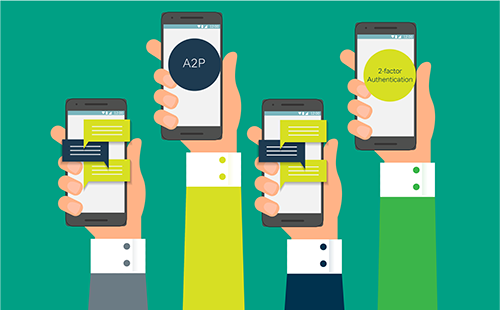How Enterprise Messaging Transforms Communication for Payment Service Providers (PSPs)

Imagine the power of reaching your customers exactly when they need you most. Whether you're notifying them of an upcoming appointment, alerting them to a recent transaction, requesting quick verification, or inviting them to an exclusive sale, our Enterprise Messaging solutions ensure your message stands out.
With our reliable and secure service, you can create real-time connections that enhance trust and loyalty, making every interaction meaningful and memorable.
So, what is Enterprise Messaging?
 It’s a robust communication solution designed for businesses to connect with their customers, employees, and stakeholders efficiently and effectively. It includes various digital messaging channels, such as SMS, email, instant messaging apps, and push notifications, enabling seamless communication across different platforms. It’s very common place today and is a vital tool for any Payment Service Provider (PSPs) who deals with high volumes of communication activity on a daily basis. PSPs can use SMS for instant transaction notifications, authentication, and verification to protect their customers.
It’s a robust communication solution designed for businesses to connect with their customers, employees, and stakeholders efficiently and effectively. It includes various digital messaging channels, such as SMS, email, instant messaging apps, and push notifications, enabling seamless communication across different platforms. It’s very common place today and is a vital tool for any Payment Service Provider (PSPs) who deals with high volumes of communication activity on a daily basis. PSPs can use SMS for instant transaction notifications, authentication, and verification to protect their customers.
In this blog we’ll look at some of the pain points PSPs face when communicating with customers and how enterprise messaging solutions can help them circumvent these issues.
How PSPs use Enterprise Messaging
Transaction alerts
Sending transaction alerts via SMS offers fast confirmation to the customer, letting them know straight away that their payment was successful. This is helpful for those unable to log into mobile banking apps while on the go.
Transaction alerts play a critical role in detecting and preventing fraud. With near-instant alerts to any transactions, customers can quickly identify any suspicious activity and take the appropriate actions to protect their accounts.
Verification and security
Multi-factor authentication is a popular method for verifying a customer's identity. The process typically sends a one-time passcode (OTP) via SMS to the customer, which they can enter on the webpage. This extra layer of security allows customers to protect their accounts from unauthorised activity, as transactions cannot be made without the OTP.
Multi-factor authentication is also used to protect online accounts from unauthorised access using the same process during login or password resets.
Customer service
Enterprise Messaging solutions can bridge the gap between a company and its customers to improve customer service and build brand loyalty. Through SMS, customers can receive timely messages about new features, services, offers, and personalised notifications to ensure they’re constantly in the loop about your company’s developments.
These messaging services can also improve customer support. With 2-Way SMS customers can directly interact directly with customer service agents without the barriers posed by apps. Unlike email, 2-Way SMS allows for real-time conversations to ensure a customer’s issue is dealt with quickly. Enterprise messaging can then be used to update the customer on the status of their support after the initial conversation.
Reminders
A surprise payment can cause issues for customers trying to manage their finances. Application-to-person (A2P) messaging can send a reminder to customers of upcoming payments and due dates and make them aware of their current balance. This will help them manage their finances without forgetting about upcoming payments.
Enterprise Messaging benefits for PSPs
Streamlining communication can be tough for Payment Service Providers, this method allows businesses to condense communication into an omnichannel solution to improve the customer experience without impacting security.
Customer experience
![]() Not everyone wants to download an app, is available for a call, or can afford to wait between emails. With 2-Way SMS every customer can receive quick assistance with whatever issue they face. It’s also a highly accessible way of communicating with customers as SMS services reach everyone with a mobile phone, whether they have a smartphone or not.
Not everyone wants to download an app, is available for a call, or can afford to wait between emails. With 2-Way SMS every customer can receive quick assistance with whatever issue they face. It’s also a highly accessible way of communicating with customers as SMS services reach everyone with a mobile phone, whether they have a smartphone or not.
Crucial communications are less likely to be missed when using SMS, as the open rate for messages is an impressive 98%, compared to just 15% for emails. This makes it the perfect choice for PSPs to send out critical messages like fraud alerts, ensuring important information is promptly received and acted upon.
Simplified communication
![]() Simplifying communication between your business and your customers can significantly improve the customer experience.
Simplifying communication between your business and your customers can significantly improve the customer experience.
Using an omnichannel solution for communication ensures that customer queries are not forgotten. With everything in one place, customer service agents can handle queries and issues easily without worrying about navigating different tools and platforms.
SMS communication also makes it easier for customers to get in touch by using a system they already know without downloading additional apps.
Enhanced security
![]() Payment Service Providers need to comply with several regulations that make multichannel communication difficult if all channels are not secured to the same standards.
Payment Service Providers need to comply with several regulations that make multichannel communication difficult if all channels are not secured to the same standards.
SMS banking presents an exciting opportunity for PSPs. With help from a trusted partner, SMS will be transmitted through secure ‘white’ routes, ensuring banks can efficiently send sensitive information with higher delivery rate accuracy.
PSD2 regulations require financial institutions to employ some form of multi-factor authentication system. SMS is the perfect solution as it offers a cross-platform service with high open rates and minimal network connectivity.
How JT can help PSPs with Enterprise Messaging
JT’s Enterprise Messaging services include A2P Messaging, MNP & HLR Routing Lookups, SMS Enterprise Messaging and 2-Way SMS. This allows PSPs to offer all the SMS services they could need without switching between different providers.
We offer high reliability, competitive and transparent pricing, and over 500 direct operator agreements worldwide.
Ready to get started?
Schedule a meeting to discuss how JT’s Enterprise Messaging services can benefit your PSP.
Categories



